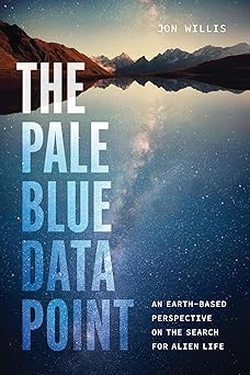Centauri Dreams
Imagining and Planning Interstellar Exploration
‘Dragonfly’ Chosen to Explore Titan
We’ve looked at a number of concepts for exploring Titan over the years, from aircraft capable of staying aloft for a year or more to balloons and boats that would float on the moon’s seas. Dragonfly, the work of a team based at Johns Hopkins University’s Applied Physics Laboratory in Laurel, MD, is a rotorcraft with the capability of exploiting Titan’s thick atmosphere to stop, sample, and move on, shaping its investigations along the way as it explores an environment rich in targets.
These are the advantages of a rover, though here we’re in a landscape so exotic that it enables different tools than the ones we use on Mars. And with the success of the Martian rovers in mind, what good news that NASA has chosen Dragonfly as the next mission in its New Frontiers program. We can anticipate launch in 2026 and arrival at Titan in 2034, with a craft that will sample surface organics and examine prebiotic chemistry and potential habitability.
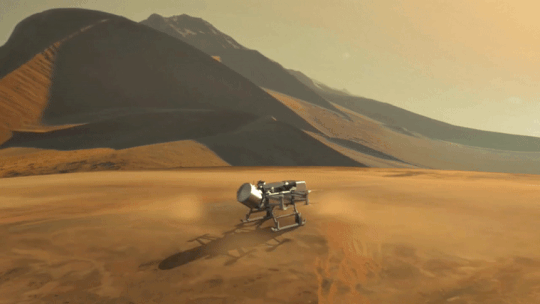
Image: This illustration shows NASA’s Dragonfly rotorcraft-lander approaching a site on Saturn’s exotic moon, Titan. Taking advantage of Titan’s dense atmosphere and low gravity, Dragonfly will explore dozens of locations across the icy world, sampling and measuring the compositions of Titan’s organic surface materials to characterize the habitability of Titan’s environment and investigate the progression of prebiotic chemistry. Credit: NASA/JHU APL.
APL’s Elizabeth ‘Zibi’ Tuttle is chief investigator for Dragonfly:
“Titan is such an amazing, complex destination. We don’t know the steps that were taken on Earth to get from chemistry to biology, but we do know that a lot of that prebiotic chemistry is actually happening on Titan today. We are beyond excited for the chance to explore and see what awaits us on this exotic world.”
No more so than all of us who lamented the end of Cassini’s mission and wondered whether the dynamic concepts for Titan exploration being offered would ever see the light of day. But think about how much Cassini itself played into Dragonfly. We have 13 years of data from the Saturn orbiter, which makes target selection a matter of choosing among abundance. The plan is for Dragonfly to land on the moon’s equator, in the dune fields now known as Shangri-La.
Dragonfly can then move on in flights of about 8 kilometers each, sampling the wide-range of Titan’s geography, while heading for an impact crater called Selk, which appears to be rich in complex molecules — carbon united with hydrogen, oxygen and nitrogen. Along the way, the mission takes advantage of Titan’s calm, dense atmosphere (four times denser than Earth’s), along with its low gravity, to travel widely. The plan is for a journey of more than 175 kilometers, twice the distance of all the Mars rovers thus far deployed.
Dragonfly itself has eight rotors, giving it the aspect of a large drone. APL talks about one hop per full Titan day, each of these being 16 Earth days, within the context of a two-year mission. Although Dragonfly in flight is a dazzling prospect, the craft will spend most of its time on the surface conducting science measurements with the help of power from a Multi-Mission Radioisotope Thermoelectric Generator (MMRTG), with recharging occurring at night.
In flight, Dragonfly will provide images of surface geology (imagine the views we are going to see, although bear in mind that during flight, the high gain antenna will be stowed — no live streaming), while scouting for ground sites to study and building up a profile of Titan’s atmosphere. On the surface, the craft will use a mass spectrometer to examine the moon’s chemistry and the production of biologically interesting compounds. A neutron-activated gamma-ray spectrometer will offer readings on surface composition, while meteorology sensors will track atmospheric variation as imaging and seismic sensors probe geologic features.
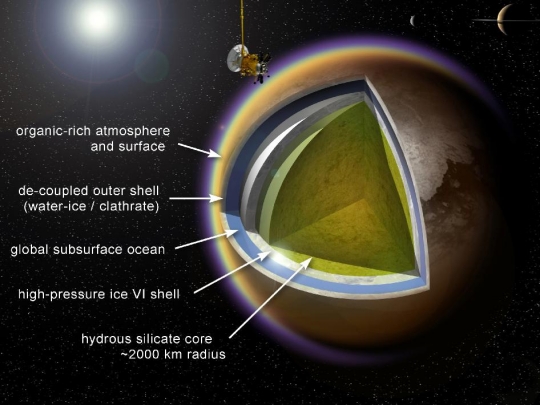
Image: This artist’s concept shows a possible model of Titan’s internal structure that incorporates data from NASA’s Cassini spacecraft. In this model, Titan is fully differentiated, which means the denser core of the moon has separated from its outer parts. This model proposes a core consisting entirely of water-bearing rocks and a subsurface ocean of liquid water. The mantle, in this image, is made of icy layers, one that is a layer of high-pressure ice closer to the core and an outer ice shell on top of the sub-surface ocean. A model of Cassini is shown making a targeted flyby over Titan’s cloudtops, with Saturn and Enceladus appearing at upper right. The model, developed by Dominic Fortes of University College London, England, incorporates data from Cassini’s radio science experiment. Credit: A. D. Fortes/UCL/STFC.
And so we begin preparations for exploring a place of liquid methane seas and the potential for liquid water beneath a surface where water ice stands in for bedrock. We’ll be studying up close an atmosphere composed primarily of nitrogen with about 5 percent methane which, when exposed to sunlight, forms complex organic compounds. All this within a hydrological cycle of methane clouds and flowing liquid methane that fills lakes and seas. Congratulations to Elizabeth ‘Zibi’ Tuttle and the entire team. What prospects await…
PI Elizabeth "Zibi" Turtle of JHUAPL showing off a 1/4 scale model of #Dragonfly on NASA Science Live. pic.twitter.com/LR2UsCWbHD
— Marcia Smith (@SpcPlcyOnline) June 27, 2019
Addendum: Paul Voosen’s article on Dragonfly on the Science site adds some details about the equipment aboard:
Dragonfly won’t be equipped with a robotic arm, like the recent Mars rovers. Its exploration will first be guided by an instrument on its belly that will bombard the ground with neutron radiation, using the gamma rays this attack releases to differentiate between basic terrain types, such as ammonia-rich ice or carbon-rich sand dunes. Its two landing skids will also each carry a rotary-percussive drill capable of taking samples and feeding them through a pneumatic tube to a mass spectrometer that can analyze their composition. The sampling system represented a risk for the mission; NASA scientists were concerned Titan’s hydrocarbon-rich atmosphere could clog it, Zurbuchen says. “It’s the oil spill version of an atmosphere.” Over the past 2 years, after extensive testing with “pathological” materials and a redesign, Turtle says, the agency’s fears were allayed.
Voosen also points out that the Dragonfly seismometer could use vibrations induced by Titan’s tidal lock with Saturn to give us some indication of the size of the ocean beneath the crust. Ultimately, the nuclear power source could last for 8 years, meaning extended missions are in the cards.

Progress on Asteroid Discovery, Impact Mitigation
We have two stories with good news on the asteroid impact front this morning. The first, out of the University of Hawaii’s Institute for Astronomy, is the announcement of the detection of a small asteroid prior to its entering the Earth’s atmosphere. That many not sound unusual, but this is the first time an object could be detected in time to move people away from a impact site, even though asteroid 2019 MO was only about 4 meters across and burned up in the atmosphere. The key is warning time, and here that time would have been half a day.
An impactor like the 20-meter object that exploded over Chelyabinsk, Russia in 2013 could, with these same methods, be detected by the ATLAS facility at Maunaloa (Hawaii) several days before impact. ATLAS is made up of two telescopes, one on Hawai?i Island, the other 160 kilometers away at Haleakal?, Maui, providing whole-sky scans every two nights. About 100 asteroids larger than 30 meters in diameter are discovered by the facility every year.
In the case of 2019 MO, the ATLAS Maunaloa site picked up the object on the morning of June 22 when it was about 500,000 kilometers from Earth. Meanwhile, the Pan-STARRS 2 survey telescope at Haleakal? had imaged the same part of the sky about two hours earlier than ATLAS, revealing the incoming asteroid. The combination of data from the two sites allowed the object’s entry path to be refined, showing a likely impact that matched later Nexrad weather data in Puerto Rico, showing an entry over the ocean about 380 kilometers south of San Juan.

Image: A map of the predicted trajectory and final impact location for asteroid 2019MO. The predicted path is based on observations from the University of Hawai?i’s ATLAS and Pan-STARRS survey telescopes. Credit: Larry Denneau (IfA/ATLAS), Brooks Bays (SOEST).
So we’re getting some lead time on impactors even at this small scale, an indication that surprises from larger objects will be less likely in the future. Likewise cheering is news from research at NASA Ames which has just appeared in a special issue of Icarus, growing out of a workshop sponsored at Ames by the NASA Planetary Defense Coordination Office. Its theme: A new look at Tunguska, the 1908 impact that wreaked havoc in Siberia.
500,000 acres of uninhabited forest were flattened by the event, which was seen by few but left enough damage to alert scientists that this had not been a volcanic explosion or a mining accident, even though the first serious investigations didn’t occur until the 1920s. Today we look back at Tunguska as a kind of signature event, says Ames scientist David Morrison:
“Tunguska is the largest cosmic impact witnessed by modern humans. It also is characteristic of the sort of impact we are likely to have to protect against in the future.”
And the good news is that computer modeling discussed in the new papers shows that the interval between impacts like Tunguska is not, as has been previously estimated, on a timescale of centuries but rather millennia. 50 million combinations of asteroid and entry properties were analyzed by the computer models deployed here, some of them trying to match atmospheric pressure waves with the seismic signals recorded on the ground at the time, while others homed in on the kind of event that could produce the Tunguska treefall pattern and soil burn distribution. Four different computer modeling codes arrived at similar conclusions.
Thus we tighten our understanding of how rocks break apart in the atmosphere. The results show a stony Tunguska impactor between 50 and 80 meters in diameter that entered the atmosphere at about 15 kilometers per second, producing the equivalent of a 10 to 30 megaton explosion at between 9.5 and 14.5 kilometers altitude. The researchers used the latest estimates of the asteroid population to make the calculation of millennia between such impacts, correcting the earlier estimate that had been based on a smaller impactor.

Image: Trees flattened by the intense shock wave created in the atmosphere as the space rock exploded above Tunguska on June 30, 1908. The photograph was taken by the Soviet Academy of Science 1929 expedition led by Leonid Kulik. 500,000 acres, the size of a large metropolitan city, were flattened. Flattening trees requires an immense shock wave. Credit: Wikimedia Commons.
The new Tunguska work also draws upon extensive video observations and maps of the Chelyabinsk event. The advances in computer models that result show that the Chelyabinsk impactor was likely a stony asteroid that broke up about 24 kilometers above the ground, producing a shock wave like that of a 550 kiloton explosion. Chelyabinsk-class objects are thought to impact the Earth every 10 to 100 years, so learning how to provide sufficient warning, as the ATLAS and Pan-STARRS work shows us is now possible, can potentially save lives.
“Because there are so few observed cases, a lot of uncertainty remains about how large asteroids break up in the atmosphere and how much damage they could cause on the ground,” says Lorien Wheeler, a researcher from Ames, working on NASA’s Asteroid Threat Assessment Project. “However, recent advancements in computational models, along with analyses of the Chelyabinsk and other meteor events, are helping to improve our understanding of these factors so that we can better evaluate potential asteroid threats in the future.”
The seven papers on Tunguska and computational modeling of impact events growing out of the Ames workshop appear in a special issue of Icarus that can be found here.

Inside ESA’s Advanced Concept Team Interstellar Workshop
It’s always good to have eyes and ears on the ground at events I can’t get to, so I was pleased when Aleksandar Shulevski contacted me with the offer to send back notes from the European Space Agency’s Advanced Concepts Team Interstellar Workshop in Noordwijk in the Netherlands. Born and raised in Bitola, Republic of Macedonia, Aleksandar is a science fiction reader and amateur astronomer who followed up electrical engineering studies in Skopje with an MSc in astronomy at Leiden University (Netherlands), dealing with calibration issues on the LOFAR radio telescope. He received a PhD from the University of Groningen, doing research on active galactic nuclei radio remnants observed with LOFAR. After working at the Netherlands Institute for Radio Astronomy (ASTRON) as junior telescope scientist, he is now a research scientist at the Anton Pannekoek Institute for Astronomy at the University of Amsterdam, specializing in low-frequency radio transients and pursuing his interest in SETI. Aleksandar could only attend half of the workshop, and unfortunately no video is available, but I’m told a fall issue of Acta Futura should include papers on many of the topics covered in Noordwijk.
by Aleksandar Shulevski
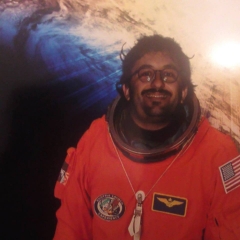
I have attended only the first day of the Interstellar Exploration workshop, organized by the Advanced Concepts Team (ACT) at the ESTEC ESA site in Noordwijk. Even though I follow the goings on in the community, I must admit that I almost missed the workshop; maybe the organizers should have advertised it more widely. Obviously this is just a personal opinion.
The program indicated potentially an interesting gathering, and I am pleased to say that I was not disappointed. The auditorium was packed, I estimate that more that the total number of participants was about 120. The technical director of ESA opened the workshop, remarking that interstellar topics are more and more in the limelight, especially since Breakthrough Initiatives launched Breakthrough Starshot: “It’s never too early to start discussing interstellar matters”.
Michael Hippke started the morning session with a popular talk on interstellar communication. He gave a thorough overview on the history of thought dealing with the problem of communicating with other worlds. The radio window was de-emphasised on account of more exotic techniques like X-ray lasers, neutrinos etc. Michael thus established the “out of the box” thinking needed for such a meeting.
Rob Swinney (BIS) gave a historical overview of fusion propulsion concepts, covering the design of the Daedalus craft, as well as the successor design effort (Icarus). His remarks were in line with his enthusiasm: “We tend to underestimate what we can do on long timescales”.
The ongoing effort funded by NASA to outline and design a mission concept for a probe to 1000 AU was the topic of the presentation by Pontus Brandt. The tentative launch date is to be sometime in the 2030s. Pontus went over past missions which are on their way out of the Solar System (Pioneer, Voyager, New Horizons), tracing their origins to a strategy for Solar System research outlined in the Simpson committee report of 1960. The committee was chaired by John A. Simpson and James A. Van Allen as part of the contribution of the Space Studies Board, which was established in 1958 to focus on space research for the National Academies of Sciences, Engineering, and Medicine.
Long term thinking is key, along with lessons learned from past experience. In a set of stunning visuals, Brandt outlined current plans. Most likely the probe will form its trajectory by a Jupiter gravity assist, burning its final fuel supply there to achieve final escape velocity considerably greater than that of Voyager 2, reaching interstellar space in 15 years. Mission goals are observations of the infrared background as well as taking the first comprehensive “outside view” of the Solar system.
Michael Waltemathe discussed the philosophical and religious aspects of interstellar travel. What if any ETIs in existence are morally superior? Will humanity export the concept of original sin among the stars? Issues like planetary protection in the interstellar context were raised, and obviously, there were few definite answers.
Phil Lubin’s presentation dealt with directed energy propulsion, discussing detailed concept designs on Breakthrough Starshot, specifically the emitter array. Excellent beam handling was reported, and no issues (apart from funding) are show-stoppers on the path of scaling up to the operational laser system. However, an issue that warrants serious research effort is the communication subsystem. Laser comms will suffer from unattainable pointing accuracy requirements. The lack of deceleration in the target system may be problematic, but potentially overcome by launching a huge number of StarChips in succession, thus replacing the need for orbiting craft. The beamer system has tangential benefits as well, like Solar System exploration applications, and planetary defense. Long term R&D commitment is needed to realize the full potential of this effort.
[PG: I notice that MIT Technology Review just posted an article looking at some of the issues involved in getting this kind of laser array operational, while reviewing other issues re Starshot that Aleksandar mentions].
The morning session was followed by a less structured period for the duration of which multiple discussion groups were formed upon the suggestion of interested attendees who proposed topics. The organizers suggested most of the questions that needed to be addressed at these sessions. I proposed to discuss the propagation effects ISM plasma would have on the radio link used for communication with a Breakthrough Starshot style StarChip. There are multiple papers on the topic and we went over David Messerschmitt’s concepts of signal conditioning, discussed at length in his book featured on Centauri Dreams in the past [for more on Messerschmitt, see for example, Is Energy a Key to Interstellar Communication?]
The discussion period was followed by a panel on which each discussion topic had a representative, and the audience had a chance to ask questions. The afternoon plenary session began with a talk by Andreas Hein on worldships, in which he presented results from his latest paper in Acta Futura. Everything else being equal, and assuming economic growth continues unabated, Hein believes Earth will be able to build a worldship in a few hundred years, although the concept of a worldship may be by then outpaced by more practical developments.
Angelo Vermeulen presented the research done by him and collaborators at TU Delft and elsewhere on evolving spacecraft which borrow from biology to convert asteroids to interstellar craft. The study focused on the life support aspects of the problem and went on to model at length various constraints like (for example) the impact of the mineral content of the asteroid being used on mission viability.
Jeffrey Punske focused on language development on generation ships. Illustrating the various (and not always obvious) reasons for language drift, he concluded that it is inevitable that the language of a generation ship will evolve so far from Earth standard in a matter of a few hundred years as to render communication between the two unintelligible, something which mission planners should take into account. He dismissed the notion that a universal translator device is a viable development. If communication becomes a ritual performed by a priestly caste on the ship using the archaic language of the predecessors, maybe communication will still be possible in some form even after the divergence occurs.
Elke Hemminger addressed the sociology of interstellar exploration. Using an interactive approach, she engaged the audience in discussing philosophical topics. What if the values we hold most dear in our current societal organization are incompatible with the mission requirements of a colony ship? What are we willing to sacrifice to make the mission a successful one? Individual freedom? Is it worth it to go to the stars if we make such sacrifices?
These are more than abstract topics and may have more immediate concern on the human condition. It can easily turn out that dealing with climate change will require modification of our values. It may well be that totalitarian societies are more suited to dealing with emergencies than democracies. How do we balance our social values against the imperative of survival?
ESA’s Advanced Concepts Team closed the session by outlining the results of the latest Global Trajectory Optimisation Competition, this time dealing with Galaxy colonization, in which three types of interstellar generational vessels are imagined to be sent around the Milky Way in a quest 90 million years long. This was the 10th edition of the GTOC competition, hosted this year by the Mission Design and Navigation section at the Jet Propulsion Laboratory. China’s solution won, in a very interesting and difficult problem posed by JPL. An August workshop will allow top teams from the competition to present papers at the Astrodynamics Specialist Conference in Maine.

Titan and Astrobiology
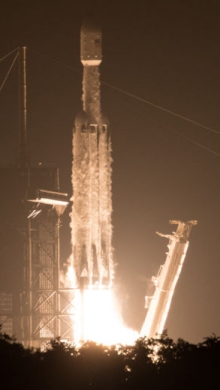
Night launches are spectacular, that’s for sure, especially with a rocket as muscular as the SpaceX Falcon Heavy. Less spectacular, at least at this point in my life, is staying up until 0230, but delays are part of the rocket business, and what counts is a launch successful in everything but the return of the center booster (both side boosters landed upright at Cape Canaveral). Prox-1, the carrier vehicle for The Planetary Society’s LightSail 2, was released at 720 kilometers, with deployment of the sail itself scheduled for July 2.
While we wait for LightSail developments and also follow the fortunes of NASA’s Deep Space Atomic Clock, launched as one of 24 satellites deployed by this bird, the 2019 Astrobiology Science Conference in Seattle draws attention this morning with new information about Saturn’s tantalizing moon Titan. I’m still having to adapt to not having Cassini in Saturn space, but without its presence scientists are proceeding with laboratory studies that re-create conditions like those on the surface of Titan. Among their findings: Compounds and minerals not found on Earth, including a ‘co-crystal’ composed of solid acetylene and butane.
I had to look this one up. A co-crystal (often written without the hyphen) is a molecular crystal with multiple components. An evidently authoritative source (G.P. Stahly, writing in a journal called Crystal Growth & Design in 2007), says that co-crystals “consist of two or more components that form a unique crystalline structure having unique properties.” In the case of the work presented by JPL’s Morgan Cable at the Astrobiology Science Conference, both acetylene and butane appear as gases on Earth, but on Titan, they are solid and combine to form crystals.
The mineral Cable’s team identified in the lab may account for a surface feature found in Cassini imagery in the form of orange shadings around the edges of Titan’s seas and lakes. We know that some of these areas show signs of evaporated material left behind as the liquid receded. These bright features show up in data from the spacecraft’s Visual and Infrared Mapping Spectrometer (VIMS) and Synthetic Aperture Radar (SAR) around lakes in the north polar region. The thinking is that organic molecules generated in the atmosphere and deposited on the surface dissolve in liquid methane and ethane and precipitate when it evaporates.
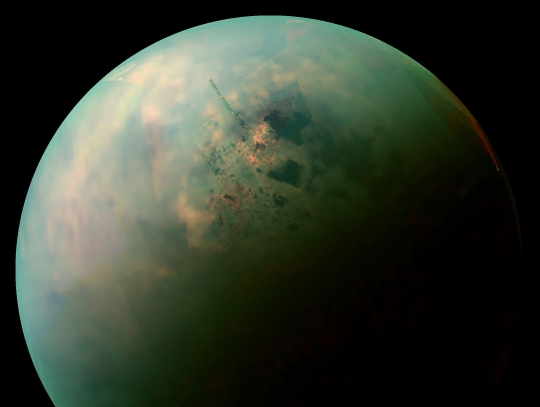
Image: A false-color, near infrared view of Titan’s northern hemisphere collected by NASA’s Cassini spacecraft shows the moon’s seas and lakes. Orange areas near some of them may be deposits of organic evaporite minerals left behind by receding liquid hydrocarbon. Credit: NASA / JPL-Caltech / Space Science Institute.
To investigate, the scientists used a cryostat filled with liquid nitrogen, gradually warming the chamber until the nitrogen turned to gas, and then adding methane and ethane along with other carbon-containing molecules. Benzene crystals emerged from the mix, creating a co-crystal with ethane molecules. The acetylene and butane co-crystal, likely more common on Titan given the moon’s composition, was then discovered. Other undiscovered hydrocarbon crystals may exist, say the researchers, although finding them will require a mission to Titan’s shorelines.
At surface temperatures in the range of 90 K, the authors believe, the acetylene-butane co-crystal “…may be ubiquitous in these regions of Titan’s surface.” Cable and colleagues are interested in chemical gradients that could potentially be exploited by life, as their presentation notes:
The catalytic hydrogenation of acetylene has been proposed as a possible energy-yielding reaction for metabolism (Schulze-Makuch et al. 2005; McKay et al. 2005; Tokano et al. 2009). It is possible that acetylene-based co-crystals might be a mechanism for storing acetylene, in a manner similar to how carbon dioxide is stored in carbonate deposits on Earth, where it might be more readily accessible to a putative microbial community.
What a complex place we’re dealing with, one whose atmosphere undergoes chemical reactions that produce organic molecules that wind up on the surface, where chemical reactions may occur as the landscape is manipulated by frigid winds and rain. A liquid water ocean beneath the surface may exchange materials with the surface over long timeframes. Being discussed at the conference is the question of whether conditions on Titan could produce the chemical complexity and particularly the energy life would demand. We’re a long way from the answer.
The presentation is Cable et al., “The Acetylene-Butane Co-Crystal: A Potentially Abundant Molecular Mineral on Titan,” with abstract here.

Into the Uranian Rings
Both DSAC (the Deep Space Atomic Clock) and LightSail 2 are on the line when a SpaceX Falcon Heavy launches on Monday evening. Both missions portend interesting developments in our push to deep space, with DSAC testing our ability to extend navigational autonomy, and LightSail 2 a solar sail that will use the power of solar photons to raise its orbit. You can follow the launch (now scheduled for 2330 Eastern (0330 UTC) on NASA Live. Also lifting off with the Falcon Heavy from the Kennedy Space Center will be almost two dozen other satellites, a nod both to the Falcon Heavy’s capabilities but also to increasing spacecraft miniaturization.
And speaking of interesting missions, here’s something good about one whose anniversary we’re about to celebrate. My friend Al Jackson, who served as astronaut trainer on the Lunar Module Simulator in the Apollo days, passed along a link to the Air-to-Ground Loop and the Flight Director’s Loop from Apollo 11. Give yourself 20 minutes or so and don’t miss this:
https://www.firstmenonthemoon.com/
On to today’s topic.
Return to the Planet of Doubt
I first mentioned Stanley Weinbaum’s story “The Planet of Doubt” back in 2011, certainly the most memorable monicker Uranus has ever received, even if Weinbaum’s Uranus doesn’t hold a candle to later imaginings from Geoff Landis and, in particular, Gerald Nordley (everyone should read Landis’ “Into the Blue Abyss” and Nordley’s brilliant “Into the Miranda Rift.”). And then there is Kim Stanley Robinson’s The Memory of Whiteness (1985), a vivid reading memory from a trip with my oldest son to Maine, where I couldn’t put it down. This is how it begins:
Dear Reader, two whitsuns orbit the planet Uranus; one is called Puck, the other, Bottom. They burn just above the swirling clouds of that giant planet, and with the help of the planet’s soft green light they illuminate all that dark corner of the solar system. Basking in the green glow of this trio are a host of worlds — little worlds, to be sure, worlds no bigger (and many smaller) than the asteroid Vesta — but worlds, nevertheless, each of them encased in a clear sphere of air like little villages in glass paperweights, and each of them a culture and society unto itself. These worlds orbit in ellipses just outside the narrow white bands of Uranus’s rings; you might say that the band of worlds forms a new ring in the planet’s old girdle: the first dozen made of ice chunks held in smooth planes, the newest made of an irregular string of soap bubbles, filled with life. And what holds all these various worlds together, what is their lingua franca? Music.
That’s quite a start, and it certainly had me hooked that summer up near Blue Hill. The Memory of Whiteness is one of the ultra-rare pieces of fiction in which the Uranian rings appear, which is why I quote it, because we’re learning more about the rings through the work of a team of scientists from UC-Berkeley and the University of Leicester in the UK, who have released updated views of the system. Here we get a glimpse of the thermal glow of these dim structures, a tough catch in visible light as well as near-infrared for any but the largest telescopes. The instruments in play are the Atacama Large Millimeter/submillimeter Array (ALMA) as well as the Very Large Telescope (VLT).
Results from both sets of observations appeared this week in The Astronomical Journal; note that the VLT work was done in 2017 using the VISIR instrument, a spectrometer working at infrared wavelengths that is now, in upgraded form, in use by the NEAR project in the search for planets around Centauri A and B. This is the first time that the temperature of these rings has been measured, at 77 Kelvin, which is the boiling temperature of liquid nitrogen. Prior images have all shown the rings in reflected sunlight. The new work offers millimeter (ALMA) and mid-infrared imaging (VLT/VISIR) to produce what you see below.
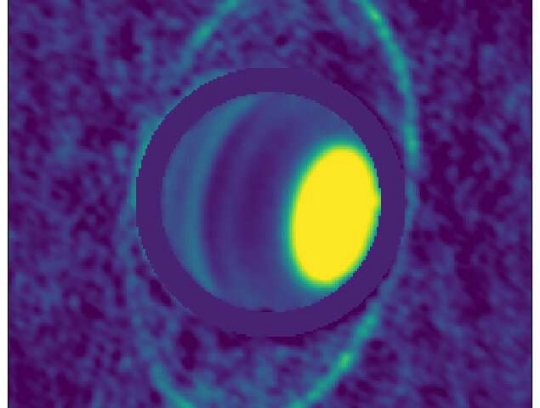
Image: Composite image of Uranus’s atmosphere and rings at radio wavelengths, taken with the ALMA array in December 2017. The image shows thermal emission, or heat, from the rings of Uranus for the first time, enabling scientists to determine their temperature: a frigid 77 Kelvin (-320 F). Dark bands in Uranus’s atmosphere at these wavelengths show the presence of molecules that absorb radio waves, in particular hydrogen sulfide gas. Bright regions like the north polar spot (yellow spot at right, because Uranus is tipped on its side) contain very few of these molecules. Credit: UC Berkeley. Image by Edward Molter and Imke de Pater.
We also learn a good deal about the composition of the rings, which differs from what we see elsewhere in the Solar system. Imke de Pater (UC-Berkeley), a co-author of the paper on this work, points to the range of particle sizes from meters down to micron-size in Saturn’s innermost D ring up to tens of meters in the main rings. At Uranus, the smaller size particles are missing in the epsilon ring, the brightest and densest of the Uranian rings, which appears to be made up of particles no smaller than golf balls. A dust component does show up between the main rings.
Graduate student Edward Molter is lead author:
“We already know that the epsilon ring is a bit weird, because we don’t see the smaller stuff. Something has been sweeping the smaller stuff out, or it’s all glomming together. We just don’t know. This is a step toward understanding their composition and whether all of the rings came from the same source material, or are different for each ring.”
These rings are also dark as charcoal, as well as being quite narrow compared to the rings of Saturn. The epsilon ring is the widest, varying from 20 to 100 kilometers in width, while Saturn’s rings can range from hundreds to tens of thousands of kilometers wide. 13 rings have thus far been found around Uranus, which Voyager flew past in 1986, likewise finding a scarcity of dust-sized particles. This sets Uranus apart from the other ice giant, for Neptune’s rings are largely dust, while gas giant Jupiter’s are mostly made up of particles of micron size.

Image: The Uranian ring system captured at different wavelengths by the ALMA and VLT telescopes. The planet itself is masked since it is very bright compared to the rings. Credit: Edward Molter, Imke de Pater, Michael Roman and Leigh Fletcher, 2019.
While the observations here are not sensitive to dust down to micron-size, the results are consistent with studies of the rings in optical and near-infrared reflected light that indicate no dust of this size is present. Here’s the paper’s conclusion:
The consensus between our millimeter and mid-infrared observations and literature visible-wavelength observations shows that the properties of the main rings remain the same at any observed wavelength despite the fact that our observations are not sensitive to micron-sized dust. This finding confirms the hypothesis, proposed based on radio occultation results (Gresh et al. 1989), that the main rings are composed of centimeter-sized or larger particles. A simple thermal model similar to the NEATM model for asteroids was applied to determine that the ring particles display roughly black-body behavior at millimeter/mid-infrared wavelengths at a temperature of 77 ± 2 K, suggesting the particles’ thermal inertia may be small enough and rotation rate slow enough, to induce longitudinal temperature differences between their dayside and nightside.
The image below, taken from earlier work, offers a near-infrared view of the rings that shows some of the interleaved dust between them, with the epsilon ring at the bottom.
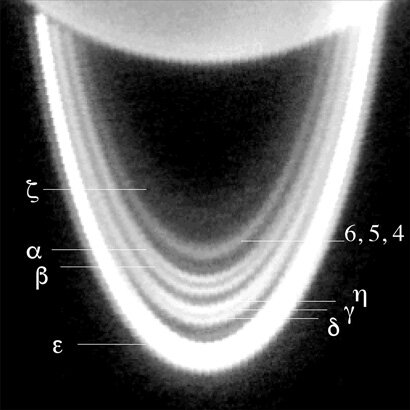
Image: Near-infrared image of the Uranian ring system taken with the adaptive optics system on the 10-meter Keck telescope in Hawaii in July 2004. The image shows reflected sunlight. In between the main rings, which are composed of centimeter-sized or larger particles, sheets of dust can be seen. The epsilon ring seen in new thermal images is at the bottom. Credit: UC Berkeley image by Imke de Pater, Seran Gibbard and Heidi Hammel, 2006.
The paper is Molter et al., “Thermal Emission from the Uranian Ring System,” accepted at The Astrophysical Journal. Preprint.

Ring Imagery from Cassini’s Deep Dive
Cassini’s productivity at Saturn continues to provide fodder for scientific papers and encouragement for the builders of complex missions, who have seen enough data gathered by this one to guarantee continuing insights into the ringed planet for years to come. The June 14 issue of Science offers up four papers (citations below) that show results from four of the spacecraft’s instruments, including startling views of the main rings.
The data examined in the Science papers were gathered during Cassini’s ring-grazing orbits from December, 2016 to April of 2017 as well as during the ‘Grand Finale’ between April and September of 2017, when Cassini flew closer than ever before to the giant planet’s cloud tops. Consider the image below, showing an infrared view as captured by the spacecraft’s Visible and Infrared Mapping Spectrometer (VIMS), with (at the left) the natural color view taken as a composite by Cassini’s Imaging Science Subsystem.
Imaging the rings in visible and near-infrared wavelengths, VIMS surprised scientists by finding weak water ice bands in the outer parts of the A ring, a seeming contradiction given the highly reflective nature of this area, which has been taken to indicate less contaminated ice and stronger water ice bands. While water ice is dominant in the rings, the spectral map shows no ammonia or methane ice, nor does it see organic compounds. This is an oddity given that organics have been found flowing out of the D ring into Saturn’s atmosphere.
“If organics were there in large amounts — at least in the main A, B and C rings — we’d see them,” says Phil Nicholson, Cassini VIMS scientist of Cornell University in Ithaca, New York. “I’m not convinced yet that they are a major component of the main rings.”
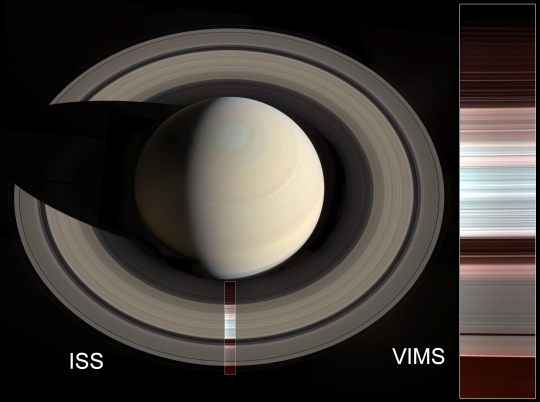
Image: The false-color image at right shows spectral mapping of Saturn’s A, B and C rings, captured by Cassini’s Visible and Infrared Mapping Spectrometer (VIMS). It displays an infrared view of the rings, rather than an image in visible light. The blue-green areas are the regions with the purest water ice and/or largest grain size (primarily the A and B rings), while the reddish color indicates increasing amounts of non-icy material and/or smaller grain sizes (primarily in the C ring and Cassini Division). At left, the same image is overlaid on a natural-color mosaic of Saturn taken by Cassini’s Imaging Science Subsystem. Credit: NASA/JPL-Caltech/University of Arizona/CNRS/LPG-Nantes. Saturn image credit: NASA/JPL-Caltech/Space Science Institute/G. Ugarkovic.
The rings, now believed to have formed much later than the planet itself, continue to deliver complexities that will feed into future models of ring evolution. The last phase of Cassini’s mission is, in the words of project scientist Linda Spilker (JPL), author of one of the papers in Science, “like turning the power up one more notch on what we could see in the rings,” a higher resolution that even as it answers some questions raises still more.
At the outer edge of the main rings, for example, impact-generated streaks appear in the F ring that are of approximately equal length and similar orientation, suggesting a string of impactors striking at the same time. The implication: The F ring, at least, is shaped by materials already orbiting Saturn rather than by materials the planet encounters in its orbit of the Sun. Small moons embedded in the rings can be considered in that sense to be sculpting them, according to Cassini scientist Matt Tiscareno (SETI Institute). Here we might see useful analogs in young exoplanet systems, where stellar systems form out of circumstellar disks that are in turn shaped by the emerging planets within them, processes out of which our own Solar System formed.
We also see how remarkably ring textures can differ even in segments close to each other, as seen in the image below. Teasing out the interactions that shaped the patterns found here will take us deeply into chemistry and temperature changes as mapped by Cassini.
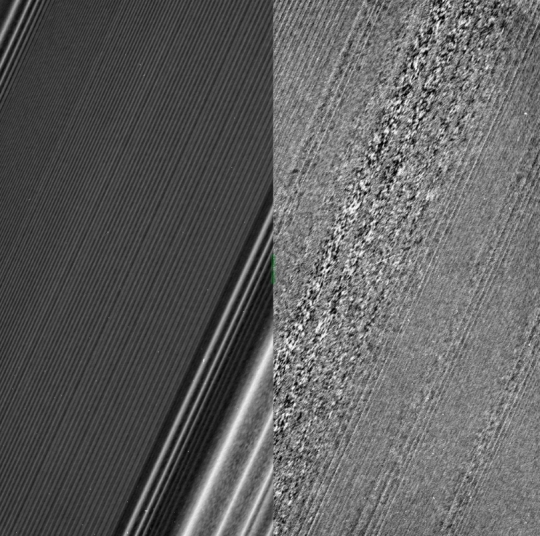
Image: New images of Saturn’s rings show how textures differ even in close proximity of one another. The image on the right has been filtered so that the newly visible straw-like textures and clumps are more visible. Credit: NASA/JPL-Caltech/Space Science Institute.
Now have a look at Daphnis, one of the embedded moons, which is here shown creating three waves in the outer edge of the Keeler Gap, at the outer edge of the A ring. The spacecraft was at a shallow 15 degree angle above the rings when the image was taken. The images here were taken in visible light using Cassini’s narrow-angle camera at a distance of about 28,000 kilometers from Daphnis and at a Sun-Daphnis-spacecraft phase angle of 71 degrees.

Image: This enhanced-color image mosaic shows Daphnis, one of the moons embedded in Saturn’s rings, in the Keeler Gap on the sunlit side of the rings. Daphnis is seen kicking up three waves in the gap’s outer edge. Three wave crests of diminishing sizes trail the moon. In each successive crest, the shape of the wave changes as the ring particles within the crest interact and collide with each other. A thin strand of ring material to the lower left of Daphnis is newly visible in this image, and there are intricate features that also hadn’t been previously observed in the third wave crest downstream. Credit: NASA/JPL-Caltech/Space Science Institute / Tilmann Denk (Freie Universität, Berlin).
And finally, this image showing the third wave crest, which displays multiple strands of ring material, an indication of the effects of Daphnis on the ring. Here we are again in visible light, now at a distance of 23,000 kilometers and at a phase angle (Sun-Daphnis-spacecraft) of 94 degrees, with an image scale of 160 meters per pixel.

Image: A closeup of the third wave crest (toward the far left in the color image) focusing on detail scientists hadn’t seen before, with multiple strands of ring material visible. The image shows how the ring material behaves after losing the structure Daphnis triggered and goes back to interacting with itself. The ribbon of material that appears to be protruding into the gap in the right-hand portion of the image is probably actually soaring above the ring plane. Toward the left-hand part of the image, that same ribbon of material dives below the ring plane and becomes obscured by the main part of the rings, which is why it disappears from view. Credit: NASA/JPL-Caltech/Space Science Institute.
I had never thought of Saturn as providing a kind of astrophysical laboratory that could illuminate processes at work in the early Solar System, but this is what the four papers in Science suggest, for here we see the kinds of interactions that take place in disk structures that contain larger accreted objects. The Cassini imagery and data will always symbolize the era of early Solar System reconnaissance on which we are embarked. Imagine what we might do with a next-generation craft, a Cassini follow-up around Uranus or Neptune.
The four papers on the Cassini ‘Grand Finale’ all appear in the June 14 issue of Science, Vol. 364, Issue 6445, and can be accessed here. They are Tiscareno et al., “Close-range remote sensing of Saturn’s rings during Cassini’s ring-grazing orbits and Grand Finale”; Buratti et al., “Close Cassini flybys of Saturn’s ring moons Pan, Daphnis, Atlas, Pandora, and Epimetheus”; Militzer et al., “Measurement and implications of Saturn’s gravity field and ring mass”; and Spilker, “Cassini-Huygens’ exploration of the Saturn system: 13 years of discovery.”

